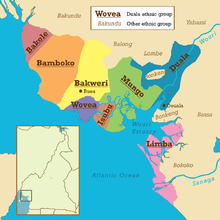Bimbia was an independent state of Isubu people of Cameroon, in 1884 annexed by the Germans and incorporated in the colony of Kamerun. It lies in Southwest Region, to the south of Mount Cameroon and to the west of the Wouri estuary.

Origins
The predominant Isubu oral history holds that the ethnic group hails from Mboko, the area southwest of Mount Cameroon.[1] Tradition makes them the descendants of Isuwu na Monanga, who led their migration to the west bank of the Wouri estuary. When a descendant of Isuwu named Mbimbi became king, the people began to refer to their territories as Bimbia.[2]
Early European contacts
Portuguese traders reached the Wouri estuary in 1472. Over the next few decades, more Europeans came to explore the estuary and the rivers that feed it, and to establish trading posts. The Isubu carved out a role for themselves as middlemen, trading ivory, kola nuts, and peppers from the interior. However, a major commodity was slaves, most bound for plantations on nearby islands such as Annobon, Fernando Po, Príncipe, and São Tomé.[3] By the 16th century, the Isubu were second only to the Duala in trade. The earliest Isubu merchants were likely chiefs or headmen.[4] Bimbia, the primary Isubu settlement, grew quickly.
Europeans traders did their best to support friendly chiefs against their rivals, adulating them with titles such as King, Prince, or Chief. In exchange, these indigenes offered trade monopolies to their patrons and sometimes ceded land.[citation needed] An Isubu chief named Bile became leader of the Isubu as King William, although Dick Merchant of Dikolo village and other chiefs eventually opposed his dominance.
British influence
British traders became the dominant European presence in the region by the mid-19th century, and the Crown used them to enforce abolition of the slave trade in the Gulf of Guinea. In 1844 and 1848, King William signed anti-slavery treaties. In exchange, the traders provided him with annual gifts of alcohol, guns, textiles, and other goods.[4]
With William's blessing, Bimbia became a haven for repatriated slaves and escapees from the illicit trade, which continued for many more years.
The British also endeavored to educate and Christianise the Bimbians.[5] King William rebuffed the earliest missionaries because he did not agree with their insistence on prayer and opposition to polygamy. In 1844, however, Joseph Merrick convinced William to let him open a church and school in Bimbia.[6] In 1858, the Spanish ousted Protestant missionaries from their base at Fernando Po. King William sold a portion of his domains to the missionary Alfred Saker, who then founded Victoria (today known as Limbe). By 1875, numerous missions and schools sprung up in Victoria and other settlements. Victoria came to be a mixture of freed slaves, working Cameroonians, and Christianised Cameroonians from the various coastal groups. Cameroonian Pidgin English began to develop at this time.
Isubu society was changed fundamentally by the European trade. European goods became status symbols, and some rulers appointed Western traders and missionaries as advisors. Large numbers of Isubu grew wealthy, leading to rising class tensions. Competition escalated between coastal groups and even between related settlements. Between 1855 and 1879, the Isubu alone engaged in at least four conflicts, both internal and with rival ethnic groups. Traders exploited this atmosphere, and beginning in 1860, German, French, and Spanish merchants had established contacts and weakened the British monopoly. The Duala had gained a virtual hegemony over trade through the Wouri estuary, and the Isubu had little power left. Young King William was virtually powerless when he succeeded his father in 1878.[7]
Treaties
On 17 February 1844, King William I of Bimbia and the chiefs of Bimbia concluded a treaty with Lieutenant Edward Charles Earl, commander of the English brig Rapid in which the slave trade was prohibited in exchange for goods worth $1,200, and free trade was guaranteed.[8] On 19 December 1850, a further treaty with Thomas Rodney Eden, captain of the Amphitrite, regulated trade terms, covering subjects such as payment of "comey", a customary fee paid by trading vessels to chiefs in exchange for permission to trade.[9] On 7 February 1855, the British Acting Consul, J.W.B. Lynslager, witnessed an engagement in which the chiefs of the Boobee (Bubi) Islands, adjacent to the Amboise (Ambas) Islands, settled the recent dispute and acknowledged King William of Bimbia's authority.[10]
German protectorate
A German protectorate over the Cameroons was declared on 12 July 1884. In a communication of 15 October 1884 the German Government described the territories included in the protectorate, which included Bimbia.[11]
References
- ^ Fanso 1989, pp. 50–51.
- ^ Fanso 1989, pp. 51.
- ^ Fanso 1989, pp. 68.
- ^ a b Fanso 1989, pp. 73.
- ^ Austen & Derrick 1999, pp. 67.
- ^ Fanso 1989, pp. 102.
- ^ Elango 1989, pp. 55.
- ^ Anyangwe 2010, pp. 15.
- ^ Anyangwe 2010, pp. 17ff.
- ^ Anyangwe 2010, pp. 19ff.
- ^ Anyangwe 2010, pp. 23.
Cited books
- Anyangwe, Carlson (2010). "British Treaties with the Chiefs of Bimbia and Victoria". The Secrets of an Aborted Decolonisation. African Books Collective. ISBN 9956-578-50-9.
{{cite book}}: Invalid|ref=harv(help) - Austen, Ralph A.; Derrick, Jonathan (1999). Middlemen of the Cameroons Rivers: the Duala and their hinterland, c.1600-c.1960. Cambridge University Press. ISBN 0-521-56664-9.
{{cite book}}: Invalid|ref=harv(help) - Elango, Lovett Z. (1989). "Trade and diplomacy on the Cameroon coast in the nineteenth century, 1833–1879: the case of Bimbia". Introduction to the History of Cameroon in the Nineteenth and Twentieth Century, Part 2. Palgrave MacMillan. ISBN 0-333-47526-7.
{{cite book}}: Invalid|ref=harv(help) - Fanso, Verkijika G. (1989). Cameroon History for Secondary Schools and Colleges: Prehistoric times to the nineteenth century. Hong Kong: Macmillan Education Ltd. ISBN 0-333-47121-0.
{{cite book}}: Invalid|ref=harv(help)